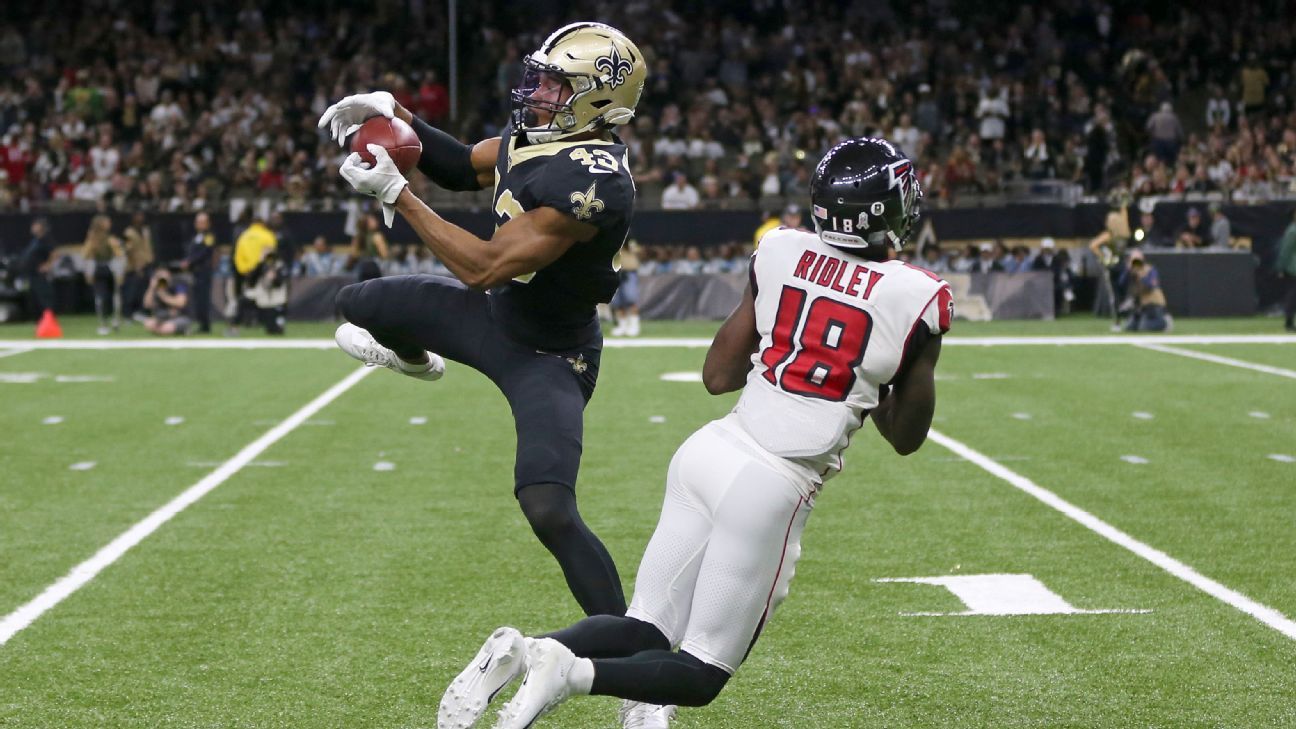OWINGS MILLS, Md. — Everyone outside the Baltimore Ravens facility trumpeted the team’s biggest needs as the offensive line, defensive line and pass rush.
Yet no one should be surprised that Baltimore’s first free-agent addition was safety Marcus Williams — unless you weren’t listening to Ravens general manager Eric DeCosta at his season-ending news conference last month.
“Our inability this year to create turnovers was probably an issue for us, and I would love to see us make the play this year coming up – intercept more passes, cause more fumbles, be more disruptive,” DeCosta said in February. “So, if the opportunity presents itself and we see a dynamic corner or a dynamic safety, of course, that would be something that would be attractive to us.”
On Tuesday, the Ravens found that dynamic safety, reaching an agreement with Williams on a five-year deal worth $70 million, a source told ESPN’s Jeremy Fowler.
Beating out the New York Jets and the Philadelphia Eagles for Williams could become the key in a dramatic turnaround on pass defense. Last season, Baltimore allowed the most passing yards in the NFL and a franchise-worst 31 touchdown passes.
Now, on the second day of free agency, the Ravens can make the argument that they have the best secondary in the league. And, honestly, this should be the top defensive backfield in football, given the investment. Over the last three years, Baltimore has spent $108 million in guaranteed money on Williams ($37 million), cornerbacks Marlon Humphrey ($40.3 million) and Marcus Peters ($21 million) and safety Chuck Clark ($10 million).
Who can blame the Ravens? Their path to the Super Bowl goes through a loaded AFC quarterback field that includes Patrick Mahomes, Josh Allen, Joe Burrow, Russell Wilson and Justin Herbert. The Ravens need the players to lock down in coverage if they want to bounce back from a last-place finish and get past the divisional round for the first time since 2012.
Baltimore knew it would be improved with the return of Pro Bowl cornerbacks Humphrey and Peters, both of whom missed a combined 22 games last season. Humphrey is a physical defender who has forced nine fumbles the past two seasons. Peters is a master at picking off the ball and has an NFL-best 31 interceptions since 2015.
With the physical presence of Clark at safety, the missing piece was a ball-hawking safety like Williams, who has totaled 15 interceptions and broken up 38 passes in his five-year career. Since 2017, Williams has been dangerous to opposing quarterbacks, making a play on the ball (recording an interception or breaking up a pass) on a league-best 27.6% of his targets, according to NFL Next Gen Stats. That’s a significant upgrade for a Ravens team that finished with nine interceptions last season, the second-fewest in franchise history.
Where the Ravens want the defense to step up is late in close games, when someone makes a play to seal the win. Over the last two seasons, Baltimore has lost 10 games by six points or fewer. During that same span, Baltimore has allowed 20 touchdown passes and recorded three interceptions in the fourth quarter.
It’s fair to wonder why Baltimore didn’t make an offensive tackle or a pass-rusher their top free-agent target. The Ravens gave up a franchise-record 57 sacks, and they haven’t had anyone produce double-digits sacks since 2017. Baltimore did sign offensive tackle Morgan Moses later Tuesday night.
But this was a deal that DeCosta couldn’t pass up. The Ravens are getting Williams, the highest-graded safety by Pro Football Focus since 2019, at $14 million per season, which ranks seventh among all safeties. Williams is entering his prime at 25 and has only been sidelined five times in his five-year career.
What you can’t criticize the Ravens for is deviating from their free agency formula. Baltimore doesn’t make many splashes at this time of year. When it does, the Ravens usually splurge on safeties. For a defense that long had Ed Reed roaming deep downfield, it feels like the Ravens have been on an endless search for another centerfielder, whether it’s Tony Jefferson, Eric Weddle or Earl Thomas.
There have been varying results, from a Pro Bowl player (Weddle) to one of the team’s biggest free-agent busts (Thomas). All were cut before their deals expired.
Williams needs to be a difference-maker, or there will be questions on why Baltimore didn’t use its limited cap space elsewhere.
